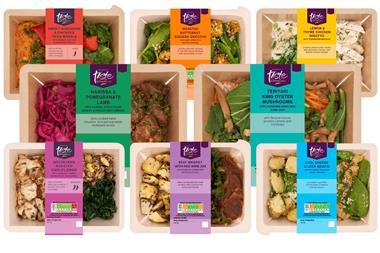Asda’s new school fundraising initiative sees it donate money when shoppers use its Rewards app. Will it be enough to accelerate sign-ups?
It’s a game-changing initiative for schools and a win-win for customers,” said Asda’s chief customer officer David Hills of the supermarket’s new ‘Cashpot for Schools’ scheme, launched earlier this week.
The initiative is uncomplicated. As its ambassador, celebrity fitness guru Joe Wicks, explains in a new ad: “You scan, Asda donates.” Customers download the Asda Rewards app, select their local school, and when they shop using Rewards, the supermarket will give the school 0.5% of the value of their shop.
The cash (Asda expects to donate £7.5m in total) will doubtless be appreciated by schools. But will the scheme resonate with shoppers? And can it burpee Asda out of the doldrums and boost take-up of its relatively new loyalty offering?
Supermarkets donating to schools is not a new phenomenon – Tesco launched its Computers for Schools campaign in 1992. Nor is it particularly novel today, with many supermarkets supporting schools through grants or charitable donations.
But Asda says its take – a percentage of a shop donated via a loyalty app – is unlike anything out there.
“This is the first,” Hills says. And its straightforwardness is significant, says Richard Exon, co-founder of creative agency Joint, which has worked with Fox’s, Thatchers and Amazon. “What I do love about Asda’s Cashpot for Schools is the simplicity. I spend money, my school gets money – no hard-to-fathom vouchers or tokens.”
Compare it with Tesco’s sports and IT equipment campaigns. As Eagle Eye’s APAC VP Jonathan Reeve – formerly of Tesco – described on LinkedIn: “The logistics were challenging. The distribution and collection of over 300 million paper vouchers made the programme costly and cumbersome for Tesco, customers, and schools alike. It’s no surprise the programme has since been discontinued.”
Cashpot for Schools instead is “bringing this community-driven initiative into the digital age” he adds.
Another criticism levelled at rival schemes of the past was the incredible sums needed to be spent for schools to ‘win’ any equipment. A 2001 Which? report, for example, found that under Tesco’s Computers for Schools promotion, people needed to buy nearly £45,000 worth of shopping for one scanner, which Tesco itself sold for £80. A new computer required £220,000 in customer spend.
All of the UK’s 22,000 state-funded primary schools get £50 from Asda from the off, then a pound for every customer that selects it, and 0.5% of their shopping thereafter – and “it doesn’t tell schools how to spend the money”, Hills says.
Crucially, it seems a small ask of shoppers: download the app, select a school, and shop. “The best campaigns are the most simple campaigns,” Hills told The Grocer. “All a customer needs to do is sign up to their nominated school within Asda Rewards and the rest is done by Asda.”

Spreading the word
In marketing terms, the scheme – like school-connected campaigns that have come before it – is a powerful one. While Wicks has been doing the radio rounds, the real hard work of spreading the word is done by the thousands of schools hoping to get their hands on Asda’s cash.
The supermarket has sent them – via PTA fundraising support charity Parentkind – a “whole pack” of imagery and guides to post on social media, place in emailed newsletters, and make into posters at the school gates. Facebook is already awash with posts from schools promoting the campaign – and urging parents to download Rewards.
“Of course there’s a commercial side to this,” Hills told The Grocer. “I would love to have [Rewards] sign-ups go through the roof. My vision is every school writes home to every parent and encourages them to shop at Asda to benefit the school.”
The scheme is also great brand-building for Asda. “Targeting schools plays well to its budget-conscious brand image at a time when consumer spending is constrained and the funding of public services is under pressure,” says retail technology expert Miya Knights.
Fergus McCallum, CEO of ad agency TBWA\MCR, which has worked with Soreen, Lidl and Guinness, agrees. “At a time when our local communities need every bit of help they can get, it’s a potentially powerful engagement tool and adds positively to Asda’s overall marketing armoury,” he says.
And given 87% of families are asked to contribute to their primary school to support funding, according to Parentkind research, it’s a cause that hits home for many.
As a result, the scheme will give Rewards “a much-needed boost” Knights says. “Given the supermarket was the last of the big four to launch a loyalty scheme two years ago, it is playing catch-up in terms of returns on its investment.”
How have mults raised money for schools?
Tesco Computers for Schools: Launched in 1992, shoppers collected vouchers for their local school to use to claim IT equipment. The amounts claimed by schools slowly diminished. The scheme was merged with a concurrent sports equipment campaign and eventually ended.
Sainsbury’s Active Kids: Running from 2005 to 2018 and fronted by various ambassadors including David Beckham, Ellie Simmonds and Lucy Bronze, the scheme saw the supermarket donate £185m worth of sports equipment to schools and clubs.
Morrisons It’s Good to Grow: Since 2021, for every £10 spent at Morrisons, shoppers receive a ‘Grow Token’ for their chosen school, which can be exchanged for gardening equipment “to get kids growing”. Downloading the MyMorrisons app is required.
Late to the party
Asda has some way to go. It says around half of transactions in its stores involve Rewards. At Tesco with Clubcard, it is 82%.
Meanwhile, due in part to its late arrival, Asda’s loyalty scheme has only six million weekly users. Tesco boasts 22 million and Sainsbury’s Nectar 18 million.
The campaign “will help it sign up more customers and drive greater frequency” Knights adds.
But some are unconvinced.
“Look at it from the perspective of a customer,” says Ged Futter, owner of consultancy The Retail Mind and a former Asda buyer. “Is this mechanic going to drive me to Asda above anywhere else? The simple answer to that will be no – because at Asda I will be spending more on my shopping than I was before. Asda’s price competitiveness is not there.”
Indeed, Tesco this year ended Asda’s decades-long run as the winner of the Grocer 33 award for price. And rivals are upping the ante with their own loyalty offerings – Morrisons last week said it was “getting the big bazooka out” in the supermarket price war, slashing prices on thousands of products for More Card holders.
Asda is steadfast in not following the ‘member prices at the shelf edge’ strategy. While its Cashpot for Schools scheme is simple enough, Rewards is less so, with customers required to shop a changing selection of products which add different amounts to a ‘cashpot’ that can then be used on future shopping trips.
Hills says getting “pounds not points” formed a big part of the appeal of Rewards. But points are no longer the prevailing mechanic in loyalty.
“Why do something completely different?” Futter asks. “That’s not the model for success. You’re making it harder for yourself.”
Unless the core loyalty offering changes, and prices drop, Futter can’t see Cashpot for Schools shifting the dial.
“Everybody’s got a limit on their own benevolence. Paying more by shopping on a weekly basis… I’m sure there will be some customers who are prepared to do that, but that’s not the majority,” he says.
Less than a week from launch, the scheme has already seen £1m raised for schools. But time will tell if shoppers will put Rewards top of the class, or it gets dismissed.




















No comments yet